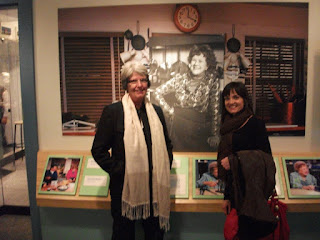For the past two Saturdays, I've been doing a Saturday field trip. This Saturday I chose Alexandria. It's a bit of a metro ride away from the city. You fly through farm and fields and get to see green. The scenic ride was a nice retreat from the asphalt jungle of the city with its parks dotted about the way.
I staked out my points of interest Friday night. I chose the Gadsby's Tavern museum and Stabler-Leadbeater Apothecary museum. I had a thematic day in mind, so I wanted to dine at Gadbsy's Tavern's restaurant where the atmosphere matched the original Tavern at the height of its days.
I get a thrill out of going into historically preserved buildings. Personal aside, I have to explain how my interest came about. I was a little girl, and I went to Carowinds, which is an amusement park that rests on the Carolinas' border and could be considered the poor man's Disneyland. At Carowinds, there is a Smurf Village. This village is smattered with (what could be considered scaled to size for a smurf) mushroom houses. Inside the mushrooms are unmade beds, clothes on ironing boards, tables spread with food, etc. I felt just like a brunette rather than blonde Smurfette. This started the thrill of stepping into a house, tavern, dwelling, etc that someone had left behind for me to step into and quasi live their life.
Now with that anecdotal aside out of the way, Gadsby's tavern opened its doors to customers in 1785. Seven years later, it opened a city hotel attached to the tavern.
The tavern was a place for men (no ladies allowed) to socialize over food, tobacco, and rum punch. As told to me by a History graduate student giving the tour, the food typically consisted of a salt cured Virginia ham, leg of lamb, fish, oysters, hominy, seasonal vegetables, and a crusty, hearty bread. An interesting point to share is that seafood was a main stable because of Alexandria's port. When an excavation team worked to unearth history in Alexandria, they found a trash heap and in this trash heap were scads of oyster shells. On the imitation, antique tables in the tavern's dining room were half-eaten plates that had the excavated oyster shells. They were sitting there as if a man with a fully, satisfied belly had just sat up from the table.
Virginia was rich with tobacco and it was smoked out of long, long pipes that were approximately the length of a flute. Men would pass the tobacco pipes around the table. The sharing of the pipe was an experience serving to tighten friendly relations be they business or communal.
Much like the pipe, the men would share the rum punch. Rum punch was made of oranges, rum, nutmeg, sugar, and likely other ingredients. The rum was poured into bowls and the men would pass the bowls around to each other. Rum punch was the preferred drink over water because waste was flushed into the bodies of water making the water unsuitable for drinking. Colonial settlers began to turn away from rum punch as it was seen to be more of a British beverage. Americans were solidifying their own sense of national pride and patriotism and in doing so were casting aside links to the British like a rum punch. Whiskey was the alternative to rum punch as it was very much American in that George Washington manufactured and sold whiskey.
All of this eating, smoking, and drinking took place in a main dining room, but tucked away in a corner was a private dining room. This private dining room could be reserved for a princely sum and women were allowed entry. This private dining room had a fireplace, elevated ceiling, and a large window. George Washington ate in that room on a few occasions. It was said he asked for hominy and roasted, canvassback duck.
On the second level, there was a grand ballroom, which by today's standards would cause a fire hazard violation if more than 100 people were in it. The only interesting piece to this room was the portable piano. The piano was terribly heavy but it was portable because its legs could fold up making it easy to carry.
On the third level, were the boarding rooms. There were three and seven men could sleep in one room. They would sleep three to a bed and some would sleep on the floor.
That concludes the tavern.
The city hotel is attached to the tavern and was built in 1792. Mr. Gadbsy, owner of tavern and hotel, was quite the entrepreneur or Donald Trump (with his Trump towers) of his day with these hotels. He chose the word "hotel" because it is a French word and would attract a certain, wealthy clientele. In this city hotel, were rooms equipped with canopied beds with tables for room service, giant windows (giant windows were a sign of stature, wealth, and elegance), and coal burning fireplaces. Coal was expensive but was known to burn cleaner than wood and could keep a room heated longer. This is what they would have considered a hotel amenity. Another feature of the hotel was its ballroom. The molding was painted Prussian blue, which was the most expensive paint you could buy at the time and burgundy, velvet curtains, the most expensive fabric, draped the windows. There was a teensy balcony for musicians to sit in to entertain and create ambience. In this ballroom, Thomas Jefferson held his inaugural ball. Now for the piece de resistance, the hotel had an ice well. The well was dug deep beneath the ground and Gadsby would have workers fill the well with ice from the surrounding bodies of water during the winters so he could sell it for an absurd amount of money in the hot, lazy days of the summer.
The pictures will provide a better explanation of it all.




























 My bed.
My bed.




